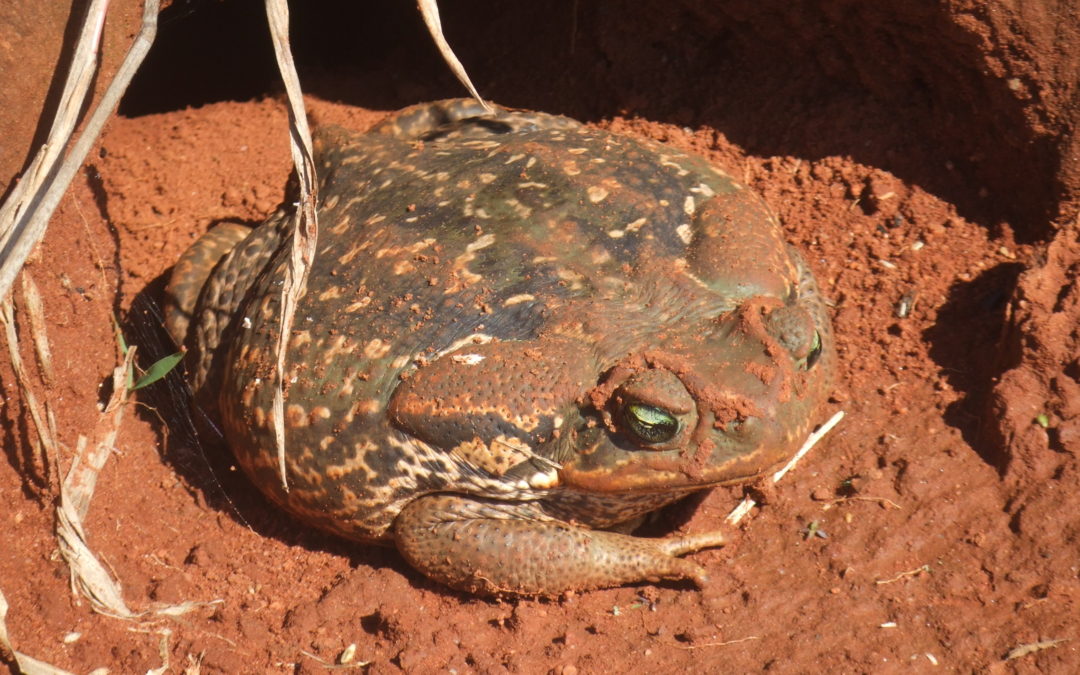In many damp dark corners of Paraguay lurks a toad. If not a toad then something smaller such as a frog may have taken up residence.
The toads of Paraguay a big beasts. They are several inches long and are solid, chunky animals. These creatures are the stuff of every Paraguayan childs nightmares. Large and seemingly unafraid of humans they will walk between a group of people to get where they wish to go.
Their ugliness and warty skins in addition to their size aid their reputation. Although folk tales and traditions say otherwise they are perfectly harmless. However the washing of hands if ever a toad is touched is probably not a bad idea.
I suspect that their apparent lack of fear and habit of taking up residence near human habitation goes a long way to explaining how strongly they are disliked. Another may be the way they are spoken of by mothers a bogey men to stop small children from wandering off out of sight.
This tradition may go back to the days when most people in Paraguay lived as parts of indigenous tribes. People then were no different then to they are now. However rather than a street outside the front door there would have been jungle. Hidden within it many things that could harm a child. Far easier to make a very visible toad a thing of terror than all that lay waiting amongst the trees.
The two most common toads in Paraguay are both of the family Rhinella. Rhinella Scheideri and Rhinella Diptycha.
Of these by the most common is Rhinella Scheideri. Its common name is Rococo Toad. It is a very large toad with a thick warty skin and protruding eyes. Also fitting a creature of such size it is heavy. Rococo Toad is capable of hopping but generally travels with slow deliberate steps. If threatened it will inflate its body to become larger still and to deter any animal from trying to swallow it.
The other common toad is Rhinella Diptycha. The common name of this toad is Cururu Toad. Although slightly smaller than Rococo Toad it is in many ways very similar. It also is often to be found seeking out beetles and the like around human habitation. Cururu is the Guarani word for toad and that it kept that name is a mark of how well known it was to the indigenous population and the Spanish settlers.
There are numerous other toads to be found in Paraguay. One further one that deserves a mention is the Paraguayan Red Bellied Toad. This is a much smaller toad with as the name suggests a red underside. It is also on the whole a resident of Paraguay rather than South America as a whole. Rococo and Cururu Toad being South American rather than solely Paraguayan toads.
All these creatures like to spend the heat of the day hidden away in a burrow or under a rock. Being amphibians dehydration is always a danger. Safer then to find somewhere dark and damp to spend the daylight hours before venturing out as the sun descends. Until fairly recently almost all Paraguayan households got their water from a well or a spring.
Such places make idea homes for fearless amphibians. In addition the light given off by candles, oil lamps or electric lights attracts the insects on which they dine from far and wide.
If there is no toad in residence and especially if there is still water near by frogs may instead move in. They are of course far smaller than the toads and so not looked at with such horror. Rather than walking they hop as all frog do. They can leap many times their body length. In the dark though those bounds are not always accurate. It is not uncommon for a startled frog to collide with the person who surprised it. A mildly shocking occurrence on a dark still night.
The smooth skin of these little frog is often patterned in shades of brown and green. There are others of brighter colours but they are less common. many of the frog are of roughly the same size, a couple of inches long, and it is only their markings that distinguishes one species from another.
Many of the frog found around human habitation are actually tree frogs. They are just as at home around houses as they are in trees. Inside or outside houses is all the same to a small tree frog. Slipping indoors is easy enough for a small, swift frog and once there plenty of hiding places are to be found. Their calls coming from behind furniture in the middle of the night can be a give away to their presence.
As with the toads, living by man also mean living in the larder. As such they have no reason to move back into the wilds. And as otherwise troublesome insects are the diet of amphibians there is little reason to send them there.


Nasty toads. You had tree frogs in your house who sounded like dogs barking
They are still around. Mostly now out in the kitchen. Toads though would not be welcome indoors